VENICE – Travel guide for opera, classical music and culture
VENICE: A guide for music fans
Visit destinations to classical music and opera art with a historical reference. Learn exciting ideas and background information.
1
MAP
Here you can find the locations of all described destinations on Google Maps.
1
2
LIVE AND WORK OF ARTISTS IN VENICE
Many famous composers like Rossini, Donizetti, Verdi or Stravinsky composed for the opera house la Fenice.
2
3
CONCERT HALLS AND OPERA HOUSES
The Fenice is the most famous and important theater in Venice. Read interesting information about the dramatic history of this theater.
3
4
CHURCHES
The St. Marks Basilica is also famous for its music. Do not miss the Assunta which inspired Wagner and Santa Maria della Salute which was inaugurated by Monteverdi.
4
4
PALAZZI
Get to know where Wagner died.
4
5
TOMBS AND GRAVES OF FAMOUS MUSICIANS
Two famous musicians are buried in Venice
5
6
RESTAURANT
Go to Richard Wagner’s favourite place to drink a cup of Coffee.
6
7
WORKS RELATING TO VENICE
Hear three pieces from Monteverdi and Rossini
7
MAP OF TOUR GUIDE DESTINATIONS
Zoom in for travel destinations:
LIVE AND WORK OF ARTISTS IN VENICE
Claudio Monteverdi
In 1613, the 46-year-old Monteverdi found himself in difficult economic circumstances. His underpaid job as maestro at the court of Mantua was on the line because the new duke was not a lover of the arts like his just-deceased predecessor. So it came in handy for Monteverdi that the position as music director of St. Mark’s Cathedral became vacant. In this important position he found the artistic and economic recognition he had been seeking.
When the plague struck in 1632, he lost his son and became ill. After his recovery, under the impact of the plague epidemic, he had himself ordained a priest.
L’incoronazione di Poppea a work for the carnival and the first civic opera
Already over 70 years old, he reinvented himself once again when Venice opera opened up to secular themes and needed operas for the carnival season. The opera was independent of a court theater and was attended by a middle-class audience seeking entertainment during the carnival season. He abandoned the usual mythological material and wrote the scathing satire “L’incoronazione di Poppea.” One of the most successful creations was the Amme Arnaulta, sung by a castrato, making Monteverdi, appropriately for Venice’s carnival season in 1643 at the age of 76, the inventor of the drag queen (more on this in the digression in the music section of this guide). The theater of the first performance, San Giovanni e Paolo, no longer exists. Shortly after the first performance of the “Incoronazione” Monteverdi died in Venice.
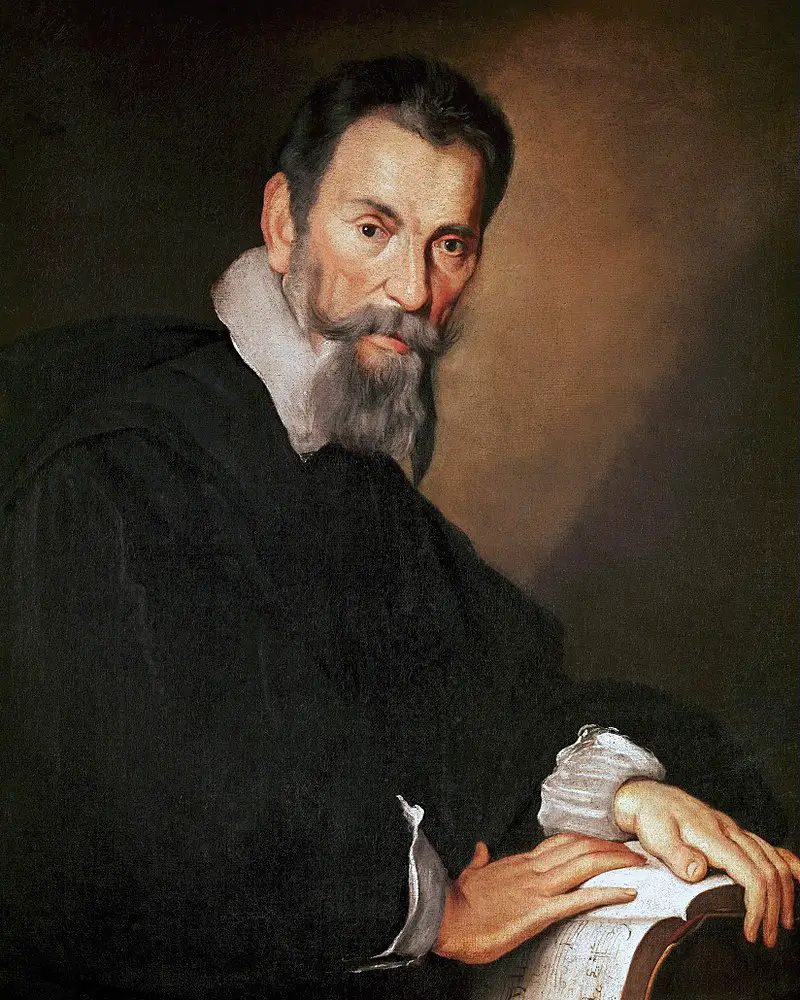
Gioachino Rossini
Venice was the gateway for Rossini’s career. He arrived in Venice at the age of 18, wrote various comedic one-act operas for the smaller theater.
With the commissioned works for the Venetian Teatro San Moisè, Rossini developed at a breathtaking pace into a leading opera composer. In this renowned theater, for which Vivaldi had already written, he wrote several one-act operas in a short time. Even the first commissioned work (“La cambiale di matrimonio”), which a family friend had arranged for the 18-year-old, was a success. The overture of the one-act opera “Il signor Bruschino” achieved anecdotal fame, in which the second violins have to tap their bows rhythmically on their music stands several times, producing a charming effect. The upscale gentlemen at the music stands, however, were too embarrassed by this effect of the 18-year-old schnoz and refused to perform the tapping sounds, causing a considerable uproar.
At the age of 21 received a commission from the great Fenice and made his breakthrough with “Tancredi”, leaving the lagoon city for Naples.
There are not many traces of Rossini left in Venice, the Teatro San Moisè is demolished, the Teatro San Benedetto (the premiere theater of the “Italiana in Algeri“) has been a cinema for ages (Multisala Rossini), only the Fenice is still standing.
The young Rossini in his Venice years:
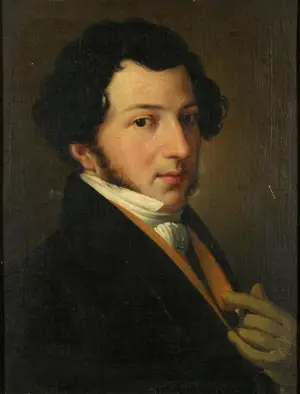
Igor Stravinsky
Stravinsky, the famous composer of “L’oiseau du feu” and “Sacré du printemps” had a special relationship with Venice, he loved this city, but he never lived there. When he visited Europe for the first time after the Second World War – he had spent the war and post-war years in the USA – Venice was the first stop. There, at the Teatro alla Fenice in 1951, he conducted his most performed opera, “The rake’s progress.” It’s a strange opera, like a throwback to times past, with harpsichord-accompanied recitatives and music that, in this atonal age, is oddly tonal in composition and at times reminiscent of Mozart, Handel and Donizetti.
Stravinsky with Dhiaghilev:
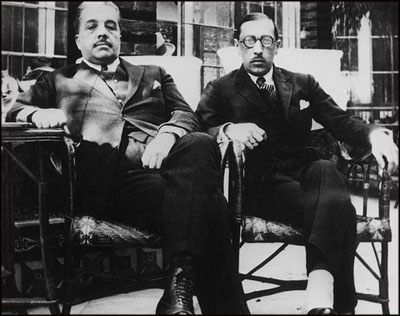
Giuseppe Verdi
The Lagoon City had the honor to premiere two of the greatest Verdian operas at the Teatro la Fenice, the “Traviata” and the “Rigoletto“. One of them became an announced fiasco and the other a surprising triumph. There were only two years between them. We will talk about the fiasco in the musical section at the end.
Not much remains of Verdi’s traces in Venice, all the more his work is cultivated.
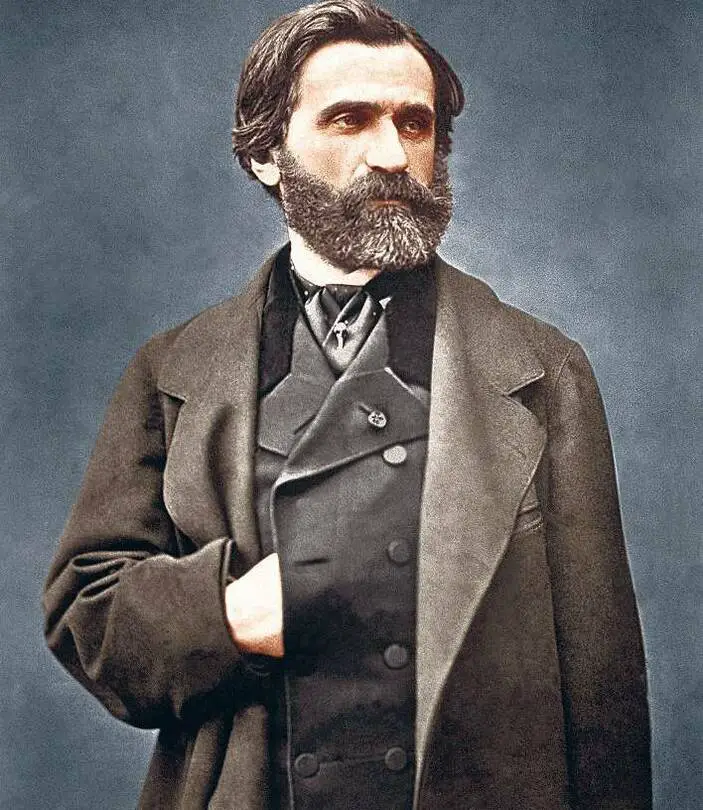
Richard Wagner
Wagner visited Venice half a dozen times. He often stayed briefly at the Danieli and then took up quarters in another place. In 1858 he visited Venice for the first time and had his grand piano brought over the Alps from Zurich, where he composed the second act of “Tristan und Isolde” in the Palazzo Giustiniani.
Four more visits took him to Venice in the following 30 years. Finally, he met his death in Venice.
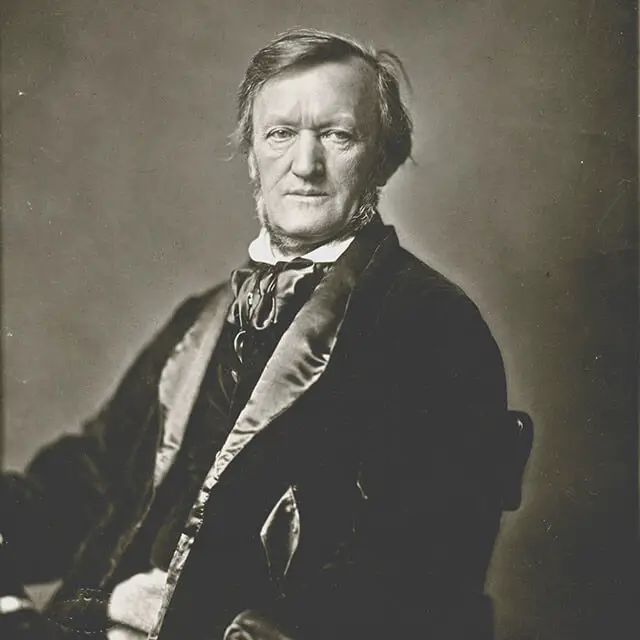
CONCERT HALLS AND OPERA HOUSES
Claudio Monteverdi
In 1613, the 46-year-old Monteverdi found himself in difficult economic circumstances. His underpaid job as maestro at the court of Mantua was on the line because the new duke was not a lover of the arts like his just-deceased predecessor. So it came in handy for Monteverdi that the position as music director of St. Mark’s Cathedral became vacant. In this important position he found the artistic and economic recognition he had been seeking.
When the plague struck in 1632, he lost his son and became ill. After his recovery, under the impact of the plague epidemic, he had himself ordained a priest.
L’incoronazione di Poppea a work for the carnival and the first civic opera
Already over 70 years old, he reinvented himself once again when Venice opera opened up to secular themes and needed operas for the carnival season. The opera was independent of a court theater and was attended by a middle-class audience seeking entertainment during the carnival season. He abandoned the usual mythological material and wrote the scathing satire “L’incoronazione di Poppea.” One of the most successful creations was the Amme Arnaulta, sung by a castrato, making Monteverdi, appropriately for Venice’s carnival season in 1643 at the age of 76, the inventor of the drag queen (more on this in the digression in the music section of this guide). The theater of the first performance, San Giovanni e Paolo, no longer exists. Shortly after the first performance of the “Incoronazione” Monteverdi died in Venice.

Gioachino Rossini
Venice was the gateway for Rossini’s career. He arrived in Venice at the age of 18, wrote various comedic one-act operas for the smaller theater.
With the commissioned works for the Venetian Teatro San Moisè, Rossini developed at a breathtaking pace into a leading opera composer. In this renowned theater, for which Vivaldi had already written, he wrote several one-act operas in a short time. Even the first commissioned work (“La cambiale di matrimonio”), which a family friend had arranged for the 18-year-old, was a success. The overture of the one-act opera “Il signor Bruschino” achieved anecdotal fame, in which the second violins have to tap their bows rhythmically on their music stands several times, producing a charming effect. The upscale gentlemen at the music stands, however, were too embarrassed by this effect of the 18-year-old schnoz and refused to perform the tapping sounds, causing a considerable uproar.
At the age of 21 received a commission from the great Fenice and made his breakthrough with “Tancredi”, leaving the lagoon city for Naples.
There are not many traces of Rossini left in Venice, the Teatro San Moisè is demolished, the Teatro San Benedetto (the premiere theater of the “Italiana in Algeri“) has been a cinema for ages (Multisala Rossini), only the Fenice is still standing.
The young Rossini in his Venice years:

Igor Stravinsky
Stravinsky, the famous composer of “L’oiseau du feu” and “Sacré du printemps” had a special relationship with Venice, he loved this city, but he never lived there. When he visited Europe for the first time after the Second World War – he had spent the war and post-war years in the USA – Venice was the first stop. There, at the Teatro alla Fenice in 1951, he conducted his most performed opera, “The rake’s progress.” It’s a strange opera, like a throwback to times past, with harpsichord-accompanied recitatives and music that, in this atonal age, is oddly tonal in composition and at times reminiscent of Mozart, Handel and Donizetti.
Stravinsky with Dhiaghilev:

Giuseppe Verdi
The Lagoon City had the honor to premiere two of the greatest Verdian operas at the Teatro la Fenice, the “Traviata” and the “Rigoletto“. One of them became an announced fiasco and the other a surprising triumph. There were only two years between them. We will talk about the fiasco in the musical section at the end.
Not much remains of Verdi’s traces in Venice, all the more his work is cultivated.

Richard Wagner
Wagner visited Venice half a dozen times. He often stayed briefly at the Danieli and then took up quarters in another place. In 1858 he visited Venice for the first time and had his grand piano brought over the Alps from Zurich, where he composed the second act of “Tristan und Isolde” in the Palazzo Giustiniani.
Four more visits took him to Venice in the following 30 years. Finally, he met his death in Venice.

CHURCHES
Claudio Monteverdi
In 1613, the 46-year-old Monteverdi found himself in difficult economic circumstances. His underpaid job as maestro at the court of Mantua was on the line because the new duke was not a lover of the arts like his just-deceased predecessor. So it came in handy for Monteverdi that the position as music director of St. Mark’s Cathedral became vacant. In this important position he found the artistic and economic recognition he had been seeking.
When the plague struck in 1632, he lost his son and became ill. After his recovery, under the impact of the plague epidemic, he had himself ordained a priest.
L’incoronazione di Poppea a work for the carnival and the first civic opera
Already over 70 years old, he reinvented himself once again when Venice opera opened up to secular themes and needed operas for the carnival season. The opera was independent of a court theater and was attended by a middle-class audience seeking entertainment during the carnival season. He abandoned the usual mythological material and wrote the scathing satire “L’incoronazione di Poppea.” One of the most successful creations was the Amme Arnaulta, sung by a castrato, making Monteverdi, appropriately for Venice’s carnival season in 1643 at the age of 76, the inventor of the drag queen (more on this in the digression in the music section of this guide). The theater of the first performance, San Giovanni e Paolo, no longer exists. Shortly after the first performance of the “Incoronazione” Monteverdi died in Venice.

Gioachino Rossini
Venice was the gateway for Rossini’s career. He arrived in Venice at the age of 18, wrote various comedic one-act operas for the smaller theater.
With the commissioned works for the Venetian Teatro San Moisè, Rossini developed at a breathtaking pace into a leading opera composer. In this renowned theater, for which Vivaldi had already written, he wrote several one-act operas in a short time. Even the first commissioned work (“La cambiale di matrimonio”), which a family friend had arranged for the 18-year-old, was a success. The overture of the one-act opera “Il signor Bruschino” achieved anecdotal fame, in which the second violins have to tap their bows rhythmically on their music stands several times, producing a charming effect. The upscale gentlemen at the music stands, however, were too embarrassed by this effect of the 18-year-old schnoz and refused to perform the tapping sounds, causing a considerable uproar.
At the age of 21 received a commission from the great Fenice and made his breakthrough with “Tancredi”, leaving the lagoon city for Naples.
There are not many traces of Rossini left in Venice, the Teatro San Moisè is demolished, the Teatro San Benedetto (the premiere theater of the “Italiana in Algeri“) has been a cinema for ages (Multisala Rossini), only the Fenice is still standing.
The young Rossini in his Venice years:

Igor Stravinsky
Stravinsky, the famous composer of “L’oiseau du feu” and “Sacré du printemps” had a special relationship with Venice, he loved this city, but he never lived there. When he visited Europe for the first time after the Second World War – he had spent the war and post-war years in the USA – Venice was the first stop. There, at the Teatro alla Fenice in 1951, he conducted his most performed opera, “The rake’s progress.” It’s a strange opera, like a throwback to times past, with harpsichord-accompanied recitatives and music that, in this atonal age, is oddly tonal in composition and at times reminiscent of Mozart, Handel and Donizetti.
Stravinsky with Dhiaghilev:

Giuseppe Verdi
The Lagoon City had the honor to premiere two of the greatest Verdian operas at the Teatro la Fenice, the “Traviata” and the “Rigoletto“. One of them became an announced fiasco and the other a surprising triumph. There were only two years between them. We will talk about the fiasco in the musical section at the end.
Not much remains of Verdi’s traces in Venice, all the more his work is cultivated.

Richard Wagner
Wagner visited Venice half a dozen times. He often stayed briefly at the Danieli and then took up quarters in another place. In 1858 he visited Venice for the first time and had his grand piano brought over the Alps from Zurich, where he composed the second act of “Tristan und Isolde” in the Palazzo Giustiniani.
Four more visits took him to Venice in the following 30 years. Finally, he met his death in Venice.

PALAZZI
Claudio Monteverdi
In 1613, the 46-year-old Monteverdi found himself in difficult economic circumstances. His underpaid job as maestro at the court of Mantua was on the line because the new duke was not a lover of the arts like his just-deceased predecessor. So it came in handy for Monteverdi that the position as music director of St. Mark’s Cathedral became vacant. In this important position he found the artistic and economic recognition he had been seeking.
When the plague struck in 1632, he lost his son and became ill. After his recovery, under the impact of the plague epidemic, he had himself ordained a priest.
L’incoronazione di Poppea a work for the carnival and the first civic opera
Already over 70 years old, he reinvented himself once again when Venice opera opened up to secular themes and needed operas for the carnival season. The opera was independent of a court theater and was attended by a middle-class audience seeking entertainment during the carnival season. He abandoned the usual mythological material and wrote the scathing satire “L’incoronazione di Poppea.” One of the most successful creations was the Amme Arnaulta, sung by a castrato, making Monteverdi, appropriately for Venice’s carnival season in 1643 at the age of 76, the inventor of the drag queen (more on this in the digression in the music section of this guide). The theater of the first performance, San Giovanni e Paolo, no longer exists. Shortly after the first performance of the “Incoronazione” Monteverdi died in Venice.

Gioachino Rossini
Venice was the gateway for Rossini’s career. He arrived in Venice at the age of 18, wrote various comedic one-act operas for the smaller theater.
With the commissioned works for the Venetian Teatro San Moisè, Rossini developed at a breathtaking pace into a leading opera composer. In this renowned theater, for which Vivaldi had already written, he wrote several one-act operas in a short time. Even the first commissioned work (“La cambiale di matrimonio”), which a family friend had arranged for the 18-year-old, was a success. The overture of the one-act opera “Il signor Bruschino” achieved anecdotal fame, in which the second violins have to tap their bows rhythmically on their music stands several times, producing a charming effect. The upscale gentlemen at the music stands, however, were too embarrassed by this effect of the 18-year-old schnoz and refused to perform the tapping sounds, causing a considerable uproar.
At the age of 21 received a commission from the great Fenice and made his breakthrough with “Tancredi”, leaving the lagoon city for Naples.
There are not many traces of Rossini left in Venice, the Teatro San Moisè is demolished, the Teatro San Benedetto (the premiere theater of the “Italiana in Algeri“) has been a cinema for ages (Multisala Rossini), only the Fenice is still standing.
The young Rossini in his Venice years:

Igor Stravinsky
Stravinsky, the famous composer of “L’oiseau du feu” and “Sacré du printemps” had a special relationship with Venice, he loved this city, but he never lived there. When he visited Europe for the first time after the Second World War – he had spent the war and post-war years in the USA – Venice was the first stop. There, at the Teatro alla Fenice in 1951, he conducted his most performed opera, “The rake’s progress.” It’s a strange opera, like a throwback to times past, with harpsichord-accompanied recitatives and music that, in this atonal age, is oddly tonal in composition and at times reminiscent of Mozart, Handel and Donizetti.
Stravinsky with Dhiaghilev:

Giuseppe Verdi
The Lagoon City had the honor to premiere two of the greatest Verdian operas at the Teatro la Fenice, the “Traviata” and the “Rigoletto“. One of them became an announced fiasco and the other a surprising triumph. There were only two years between them. We will talk about the fiasco in the musical section at the end.
Not much remains of Verdi’s traces in Venice, all the more his work is cultivated.

Richard Wagner
Wagner visited Venice half a dozen times. He often stayed briefly at the Danieli and then took up quarters in another place. In 1858 he visited Venice for the first time and had his grand piano brought over the Alps from Zurich, where he composed the second act of “Tristan und Isolde” in the Palazzo Giustiniani.
Four more visits took him to Venice in the following 30 years. Finally, he met his death in Venice.

TOMBS AND GRAVES OF FAMOUS MUSICIANS
Claudio Monteverdi
In 1613, the 46-year-old Monteverdi found himself in difficult economic circumstances. His underpaid job as maestro at the court of Mantua was on the line because the new duke was not a lover of the arts like his just-deceased predecessor. So it came in handy for Monteverdi that the position as music director of St. Mark’s Cathedral became vacant. In this important position he found the artistic and economic recognition he had been seeking.
When the plague struck in 1632, he lost his son and became ill. After his recovery, under the impact of the plague epidemic, he had himself ordained a priest.
L’incoronazione di Poppea a work for the carnival and the first civic opera
Already over 70 years old, he reinvented himself once again when Venice opera opened up to secular themes and needed operas for the carnival season. The opera was independent of a court theater and was attended by a middle-class audience seeking entertainment during the carnival season. He abandoned the usual mythological material and wrote the scathing satire “L’incoronazione di Poppea.” One of the most successful creations was the Amme Arnaulta, sung by a castrato, making Monteverdi, appropriately for Venice’s carnival season in 1643 at the age of 76, the inventor of the drag queen (more on this in the digression in the music section of this guide). The theater of the first performance, San Giovanni e Paolo, no longer exists. Shortly after the first performance of the “Incoronazione” Monteverdi died in Venice.

Gioachino Rossini
Venice was the gateway for Rossini’s career. He arrived in Venice at the age of 18, wrote various comedic one-act operas for the smaller theater.
With the commissioned works for the Venetian Teatro San Moisè, Rossini developed at a breathtaking pace into a leading opera composer. In this renowned theater, for which Vivaldi had already written, he wrote several one-act operas in a short time. Even the first commissioned work (“La cambiale di matrimonio”), which a family friend had arranged for the 18-year-old, was a success. The overture of the one-act opera “Il signor Bruschino” achieved anecdotal fame, in which the second violins have to tap their bows rhythmically on their music stands several times, producing a charming effect. The upscale gentlemen at the music stands, however, were too embarrassed by this effect of the 18-year-old schnoz and refused to perform the tapping sounds, causing a considerable uproar.
At the age of 21 received a commission from the great Fenice and made his breakthrough with “Tancredi”, leaving the lagoon city for Naples.
There are not many traces of Rossini left in Venice, the Teatro San Moisè is demolished, the Teatro San Benedetto (the premiere theater of the “Italiana in Algeri“) has been a cinema for ages (Multisala Rossini), only the Fenice is still standing.
The young Rossini in his Venice years:

Igor Stravinsky
Stravinsky, the famous composer of “L’oiseau du feu” and “Sacré du printemps” had a special relationship with Venice, he loved this city, but he never lived there. When he visited Europe for the first time after the Second World War – he had spent the war and post-war years in the USA – Venice was the first stop. There, at the Teatro alla Fenice in 1951, he conducted his most performed opera, “The rake’s progress.” It’s a strange opera, like a throwback to times past, with harpsichord-accompanied recitatives and music that, in this atonal age, is oddly tonal in composition and at times reminiscent of Mozart, Handel and Donizetti.
Stravinsky with Dhiaghilev:

Giuseppe Verdi
The Lagoon City had the honor to premiere two of the greatest Verdian operas at the Teatro la Fenice, the “Traviata” and the “Rigoletto“. One of them became an announced fiasco and the other a surprising triumph. There were only two years between them. We will talk about the fiasco in the musical section at the end.
Not much remains of Verdi’s traces in Venice, all the more his work is cultivated.

Richard Wagner
Wagner visited Venice half a dozen times. He often stayed briefly at the Danieli and then took up quarters in another place. In 1858 he visited Venice for the first time and had his grand piano brought over the Alps from Zurich, where he composed the second act of “Tristan und Isolde” in the Palazzo Giustiniani.
Four more visits took him to Venice in the following 30 years. Finally, he met his death in Venice.

RESTAURANTS
Claudio Monteverdi
In 1613, the 46-year-old Monteverdi found himself in difficult economic circumstances. His underpaid job as maestro at the court of Mantua was on the line because the new duke was not a lover of the arts like his just-deceased predecessor. So it came in handy for Monteverdi that the position as music director of St. Mark’s Cathedral became vacant. In this important position he found the artistic and economic recognition he had been seeking.
When the plague struck in 1632, he lost his son and became ill. After his recovery, under the impact of the plague epidemic, he had himself ordained a priest.
L’incoronazione di Poppea a work for the carnival and the first civic opera
Already over 70 years old, he reinvented himself once again when Venice opera opened up to secular themes and needed operas for the carnival season. The opera was independent of a court theater and was attended by a middle-class audience seeking entertainment during the carnival season. He abandoned the usual mythological material and wrote the scathing satire “L’incoronazione di Poppea.” One of the most successful creations was the Amme Arnaulta, sung by a castrato, making Monteverdi, appropriately for Venice’s carnival season in 1643 at the age of 76, the inventor of the drag queen (more on this in the digression in the music section of this guide). The theater of the first performance, San Giovanni e Paolo, no longer exists. Shortly after the first performance of the “Incoronazione” Monteverdi died in Venice.

Gioachino Rossini
Venice was the gateway for Rossini’s career. He arrived in Venice at the age of 18, wrote various comedic one-act operas for the smaller theater.
With the commissioned works for the Venetian Teatro San Moisè, Rossini developed at a breathtaking pace into a leading opera composer. In this renowned theater, for which Vivaldi had already written, he wrote several one-act operas in a short time. Even the first commissioned work (“La cambiale di matrimonio”), which a family friend had arranged for the 18-year-old, was a success. The overture of the one-act opera “Il signor Bruschino” achieved anecdotal fame, in which the second violins have to tap their bows rhythmically on their music stands several times, producing a charming effect. The upscale gentlemen at the music stands, however, were too embarrassed by this effect of the 18-year-old schnoz and refused to perform the tapping sounds, causing a considerable uproar.
At the age of 21 received a commission from the great Fenice and made his breakthrough with “Tancredi”, leaving the lagoon city for Naples.
There are not many traces of Rossini left in Venice, the Teatro San Moisè is demolished, the Teatro San Benedetto (the premiere theater of the “Italiana in Algeri“) has been a cinema for ages (Multisala Rossini), only the Fenice is still standing.
The young Rossini in his Venice years:

Igor Stravinsky
Stravinsky, the famous composer of “L’oiseau du feu” and “Sacré du printemps” had a special relationship with Venice, he loved this city, but he never lived there. When he visited Europe for the first time after the Second World War – he had spent the war and post-war years in the USA – Venice was the first stop. There, at the Teatro alla Fenice in 1951, he conducted his most performed opera, “The rake’s progress.” It’s a strange opera, like a throwback to times past, with harpsichord-accompanied recitatives and music that, in this atonal age, is oddly tonal in composition and at times reminiscent of Mozart, Handel and Donizetti.
Stravinsky with Dhiaghilev:

Giuseppe Verdi
The Lagoon City had the honor to premiere two of the greatest Verdian operas at the Teatro la Fenice, the “Traviata” and the “Rigoletto“. One of them became an announced fiasco and the other a surprising triumph. There were only two years between them. We will talk about the fiasco in the musical section at the end.
Not much remains of Verdi’s traces in Venice, all the more his work is cultivated.

Richard Wagner
Wagner visited Venice half a dozen times. He often stayed briefly at the Danieli and then took up quarters in another place. In 1858 he visited Venice for the first time and had his grand piano brought over the Alps from Zurich, where he composed the second act of “Tristan und Isolde” in the Palazzo Giustiniani.
Four more visits took him to Venice in the following 30 years. Finally, he met his death in Venice.

WORKS RELATING TO VENICE
Claudio Monteverdi
In 1613, the 46-year-old Monteverdi found himself in difficult economic circumstances. His underpaid job as maestro at the court of Mantua was on the line because the new duke was not a lover of the arts like his just-deceased predecessor. So it came in handy for Monteverdi that the position as music director of St. Mark’s Cathedral became vacant. In this important position he found the artistic and economic recognition he had been seeking.
When the plague struck in 1632, he lost his son and became ill. After his recovery, under the impact of the plague epidemic, he had himself ordained a priest.
L’incoronazione di Poppea a work for the carnival and the first civic opera
Already over 70 years old, he reinvented himself once again when Venice opera opened up to secular themes and needed operas for the carnival season. The opera was independent of a court theater and was attended by a middle-class audience seeking entertainment during the carnival season. He abandoned the usual mythological material and wrote the scathing satire “L’incoronazione di Poppea.” One of the most successful creations was the Amme Arnaulta, sung by a castrato, making Monteverdi, appropriately for Venice’s carnival season in 1643 at the age of 76, the inventor of the drag queen (more on this in the digression in the music section of this guide). The theater of the first performance, San Giovanni e Paolo, no longer exists. Shortly after the first performance of the “Incoronazione” Monteverdi died in Venice.

Gioachino Rossini
Venice was the gateway for Rossini’s career. He arrived in Venice at the age of 18, wrote various comedic one-act operas for the smaller theater.
With the commissioned works for the Venetian Teatro San Moisè, Rossini developed at a breathtaking pace into a leading opera composer. In this renowned theater, for which Vivaldi had already written, he wrote several one-act operas in a short time. Even the first commissioned work (“La cambiale di matrimonio”), which a family friend had arranged for the 18-year-old, was a success. The overture of the one-act opera “Il signor Bruschino” achieved anecdotal fame, in which the second violins have to tap their bows rhythmically on their music stands several times, producing a charming effect. The upscale gentlemen at the music stands, however, were too embarrassed by this effect of the 18-year-old schnoz and refused to perform the tapping sounds, causing a considerable uproar.
At the age of 21 received a commission from the great Fenice and made his breakthrough with “Tancredi”, leaving the lagoon city for Naples.
There are not many traces of Rossini left in Venice, the Teatro San Moisè is demolished, the Teatro San Benedetto (the premiere theater of the “Italiana in Algeri“) has been a cinema for ages (Multisala Rossini), only the Fenice is still standing.
The young Rossini in his Venice years:

Igor Stravinsky
Stravinsky, the famous composer of “L’oiseau du feu” and “Sacré du printemps” had a special relationship with Venice, he loved this city, but he never lived there. When he visited Europe for the first time after the Second World War – he had spent the war and post-war years in the USA – Venice was the first stop. There, at the Teatro alla Fenice in 1951, he conducted his most performed opera, “The rake’s progress.” It’s a strange opera, like a throwback to times past, with harpsichord-accompanied recitatives and music that, in this atonal age, is oddly tonal in composition and at times reminiscent of Mozart, Handel and Donizetti.
Stravinsky with Dhiaghilev:

Giuseppe Verdi
The Lagoon City had the honor to premiere two of the greatest Verdian operas at the Teatro la Fenice, the “Traviata” and the “Rigoletto“. One of them became an announced fiasco and the other a surprising triumph. There were only two years between them. We will talk about the fiasco in the musical section at the end.
Not much remains of Verdi’s traces in Venice, all the more his work is cultivated.

Richard Wagner
Wagner visited Venice half a dozen times. He often stayed briefly at the Danieli and then took up quarters in another place. In 1858 he visited Venice for the first time and had his grand piano brought over the Alps from Zurich, where he composed the second act of “Tristan und Isolde” in the Palazzo Giustiniani.
Four more visits took him to Venice in the following 30 years. Finally, he met his death in Venice.


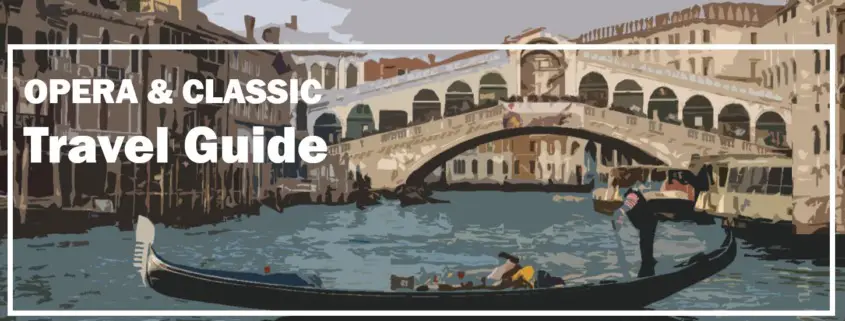


Leave a Reply
Want to join the discussion?Feel free to contribute!